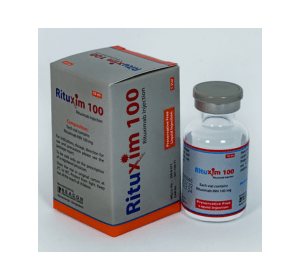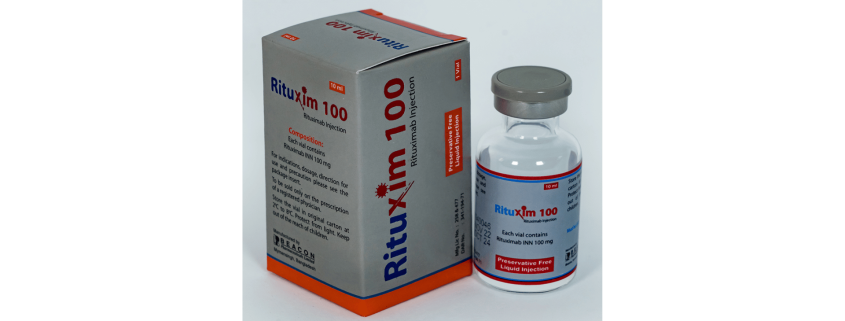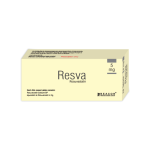Rituxim

Generic Name:Rituximab
Indications
Non-Hodgkin’s Lymphoma (NHL): Relapsed or refractory, low-grade or follicular, CD20-positive, B-cell NHL as a single agent.
Previously untreated follicular, CD20-positive, B-cell NHL in combination with first line chemotherapy and, in patients achieving a complete or partial response to a Rituxim product in combination with chemotherapy, as single-agent maintenance therapy.
Non-progressing (including stable disease), low-grade, CD20-positive, B-cell NHL as a single agent after first-line cyclophosphamide, vincristine, and prednisone (CVP) chemotherapy.
Previously untreated diffuse large B-cell, CD20-positive NHL in combination with cyclophosphamide, doxorubicin, vincristine, prednisone (CHOP) or other anthracycline-based chemotherapy regimens. Rituxim is indicated for the treatment of pediatric patients aged 6 months and older
Previously untreated, advanced stage, CD20-positive diffuse large B-cell lymphoma (DLBCL), Burkitt lymphoma (BL), Burkitt-like lymphoma (BLL) or mature B-cell acute leukemia (B-AL) in combination with chemotherapy.
Chronic Lymphocytic Leukemia (CLL): Rituxim, in combination with fludarabine and cyclophosphamide (FC), is indicated for the treatment of adult patients with previously untreated and previously treated CD20-positive CLL.
Rheumatoid Arthritis (RA): Rituxim, in combination with methotrexate, is indicated for the treatment of adult patients with moderately- to severely-active rheumatoid arthritis who have had an inadequate response to one or more TNF antagonist therapies.
Granulomatosis with Polyangiitis (GPA) (Wegener’s Granulomatosis) and Microscopic Polyangiitis (MPA): Rituxim, in combination with glucocorticoids, is indicated for the treatment of adult and pediatric patients 2 years of age and older with Granulomatosis with Polyangiitis (GPA) (Wegener’s Granulomatosis) and Microscopic Polyangiitis (MPA).
Pemphigus Vulgaris (PV): Rituxim is indicated for the treatment of adult patients with moderate to severe pemphigus vulgaris.
Pharmacology
Rituximab is a genetically engineered chimeric murine/human monoclonal IgG1 kappa antibody directed against the CD20 antigen. Rituximab has an approximate molecular weight of 145 kD. Rituximab has a binding affinity for the CD20 antigen of approximately 8.0 nM.
Dosage & Administration
Administration only as an Intravenous Infusion: It should not be administered as an intravenous push or bolus. Rituximab should only be administered by a healthcare professional with appropriate medical support to manage severe infusion-related reactions that can be fatal if they occur. It should be premedicated before each infusion. Or, as directed by the registered physicians.
First Infusion: Standard Infusion: Initiate infusion at a rate of 50 mg/hr. In the absence of infusion toxicity, increase infusion rate by 50 mg/hr increments every 30 minutes, to a maximum of 400 mg/hr.
For Pediatric Patients with mature B-cell NHL/B-AL: Initiate infusion at a rate of 0.5 mg/kg/hr (maximum 50 mg/hr). In the absence of infusion toxicity, increase infusion rate by 0.5 mg/kg/hr every 30 minutes, to a maximum of 400 mg/hr.
Subsequent Infusions: Standard Infusion: Initiate infusion at a rate of 100 mg/hr. In the absence of infusion toxicity, increase rate by 100 mg/hr increments at 30-minute intervals, to a maximum of 400 mg/hr. For Previously Untreated Follicular NHL and DLBCL adult patients: If patients did not experience a Grade 3 or 4 infusion-related adverse event during Cycle 1, a 90-minute infusion can be administered in Cycle 2 with a glucocorticoid-containing chemotherapy regimen. Initiate at a rate of 20% of the total dose given in the first 30 minutes and the remaining 80% of the total dose given over the next 60 minutes. If the 90-minute infusion is tolerated in Cycle 2, the same rate can be used when administering the remainder of the treatment regimen (through Cycle 6 or 8). Patients who have clinically significant cardiovascular disease or who have a circulating lymphocyte count greater than or equal to 5,000/mm3 before Cycle 2 should not be administered the 90-minute infusion.
Recommended Dose for Non-Hodgkin’s Lymphoma (NHL): The recommended dose is 375 mg/m 2 as an intravenous infusion according to the following schedules
Relapsed or Refractory, Low-Grade or Follicular, CD20-Positive, B-Cell NHL: It should be administered once weekly for 4 or 8 doses.
Retreatment for Relapsed or Refractory, Low-Grade or Follicular, CD20-Positive, B-Cell NHL: It should be administered once weekly for 4 doses.
Previously Untreated, Follicular, CD20-Positive, B-Cell NHL: It should be administered on Day 1 of each cycle of chemotherapy for up to 8 doses. In patients with complete or partial response, initiate Rituximab maintenance eight weeks following completion of a rituximab product in combination with chemotherapy. It should be administered as a single-agent every 8 weeks for 12 doses.
Non-progressing, Low-Grade, CD20-Positive, B-Cell NHL, after first-line CVP chemotherapy: Following completion of 6-8 cycles of CVP chemotherapy, It should be administered once weekly for 4 doses at 6-month intervals to a maximum of 16 doses.
Diffuse Large B-Cell NHL: It should be administered on Day 1 of each cycle of chemotherapy for up to 8 infusions.
Pediatric patients aged 6 months and older with previously untreated mature B-cell NHL/B-AL: Rituximab is given in combination with systemic Lymphome Malin B (LMB) chemotherapy. In total, six infusions of Rituximab are given, two doses during each of the induction courses, COPDAM1 and COPDAM2, and one dose during each of the two consolidation courses of CYM/CYVE.
Recommended Dose for Chronic Lymphocytic Leukemia (CLL): The recommended dose is 375 mg/m 2 the day prior to the initiation of FC chemotherapy, then 500 mg/m 2 on Day 1 of cycles 2-6 (every 28 days).
Recommended Dose for Rheumatoid Arthritis (RA): Rituximab should be administered as two-1,000 mg intravenous infusions separated by 2 weeks. Glucocorticoids administered as methylprednisolone 100 mg intravenous or its equivalent 30 minutes prior to each infusion are recommended to reduce the incidence and severity of infusion-related reactions. Subsequent courses should be administered every 24 weeks or based on clinical evaluation, but not sooner than every 16 weeks. Rituximab is given in combination with methotrexate.
Recommended Dose for Granulomatosis with Polyangiitis (GPA) (Wegener’s Granulomatosis) and Microscopic Polyangiitis (MPA): Rituximab should be administered as a 375 mg/m 2 intravenous infusion once weekly for 4 weeks for patients with active GPA or MPA. Glucocorticoids administered as methylprednisolone 1,000 mg intravenously per day for 1 to 3 days followed by oral prednisone as per clinical practice. This regimen should begin within 14 days prior to or with the initiation of Rituximab and may continue during and after the 4 week induction course of Rituximab treatment.
Recommended Dose for Pemphigus Vulgaris (PV): Rituximab should be administered as two-1,000 mg intravenous infusions separated by 2 weeks in combination with a tapering course of glucocorticoids.
Maintenance treatment: Rituximab should be administered as a 500 mg intravenous infusion at Month 12 and every 6 months thereafter or based on clinical evaluation.
Treatment of relapse: Rituximab should be administered as a 1,000 mg intravenous infusion on relapse, and consider resuming or increasing the glucocorticoid dose based on clinical evaluation. Subsequent infusions of Rituximab may be administered no sooner than 16 weeks following the previous infusion.



